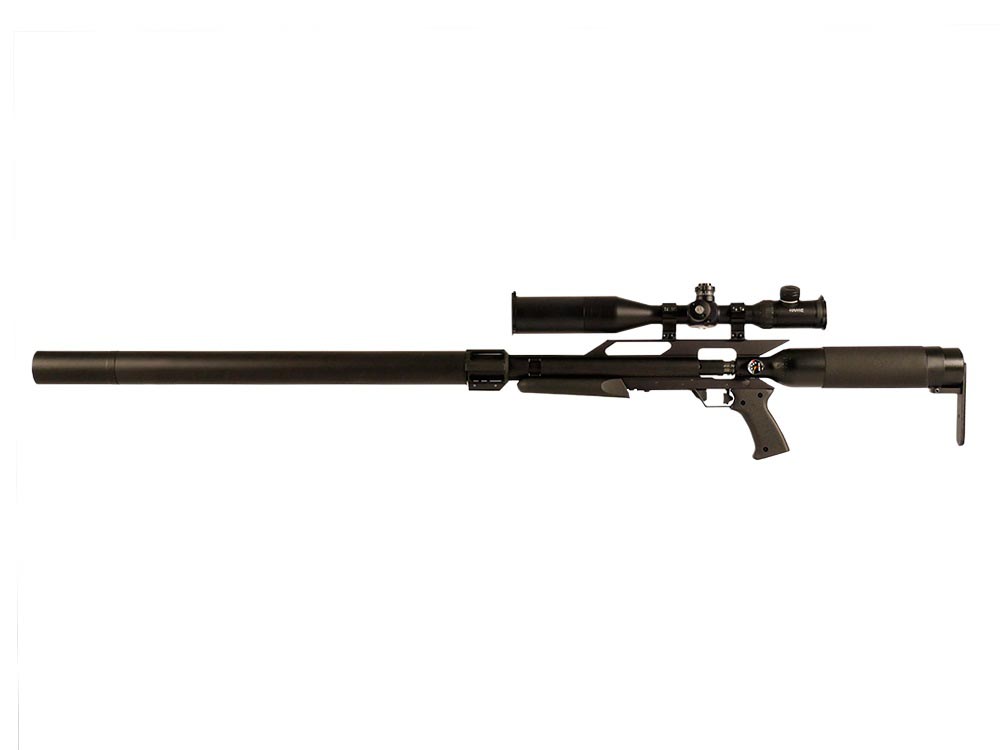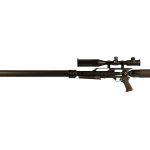It wasn’t long ago that the prevailing opinion about what was “long-range” with an airgun would have topped out around 50 to 75 yards. The market has certainly changed a lot over the last couple of decades. Now, even affordable PCP airguns are expected to deliver consistent accuracy at a minimum of 50 yards, and more and more shooters are looking for much more than that. So as we look at some ways to prepare to shoot long-range, let’s first decide what is “long-range.” For the sake of this article, we’ll set the standard at 100 yards.
Next, we need to look at what will be the minimum shot group that we’ll consider accurate at 100 yards. The buzz phrase in “accuracy land” is SUB MOA. SUB MOA stands for “sub minute of angle,” which, for simplicity, equals about .25” at 25 yards, .5” at 50 yards, and 1” at 100 yards. Because it’s an “angle,” the maximum acceptable group will increase based on distance. So a SUB MOA group at 200 yards would need to be less than 2” center to center. While it would be awesome for all airguns to be able to shoot SUB MOA, the reality is that the majority are not able to do so. Be it the engineering, the ammo, the shooting conditions, or the shooter behind the trigger, finding an airgun that can deliver consistent SUB MOA results at 100 yards is nearly impossible. Realistically, if you can find an airgun, optic, and ammo combination that can deliver 2 MOA results seven out of ten times, then you’ve found yourself a great setup. (2 MOA would be: .5” at 25 yards, 1” at 50 yards, and 2” at 100 yards, etc.)
With that out of the way, what can you do to develop the necessary skills to shoot PCP airguns long-range? Let’s get into it.
Know Your Airgun
It’s important to know your gear before you start trying to shoot for precision long-range. To really know if your PCP airgun has the potential for long-range accuracy, it needs to deliver consistent velocity for each shot. To know how your airgun is performing, you’ll need a device called a chronograph. It will tell you the velocity of each shot. Many will also tell you the “standard deviation” across multiple shots. This is important because it gives you an idea of the overall consistency, which is critical. If your airgun can’t deliver a standard deviation of, say, 4 FPS, then it’s not going to get the job done. If it can, then at least you know you have the potential for success.
See Your Target
You have to be able to see it to hit it. Good glass, in other words a high-quality optic, is critical for achieving success in long-range accuracy. People will have different likes and dislikes when it comes to optics, but we would recommend something that has at least a 16x magnification, and really 24x would be better, for shooting precision at 100 yards. Something like the Hawke Sidewinder line is a great place to look. Don’t skimp on your glass. You’ll be pleased you didn’t.
Check Your Ammo
It may take some time for you to find the best ammo for your airgun. Additionally, ammo that shoots great up close may fall apart long-range. Whatever you settle on, you’ll need to make sure that each pellet or slug is as identical as possible to the other. This may mean that you’ll need to spend some time hand sorting, washing, and weighing each pellet to give yourself the best possible chance of success.
Start Close Before You Go Long
Our first tip may seem counterintuitive. If you want to shoot far away, then you need to practice far away, right? Well, maybe not. Ultimately, you’ll need to shoot at 100 yards to make sure that you and your gear can actually accomplish what you want, but because we are working with an “angle,” you can actually shoot at as little as 10 yards. At 10 yards, 2 MOA would be .2” CTC. The bottom line is that if you can’t shoot 2 MOA at 10 yards, you are not going to get any better the further out you go. The technique is going to be the same. Once you can consistently shoot SUB 2 MOA groups at 10 yards, then move back to 25 yards and start the process over.
Shoot Small
Once you’ve started to gain confidence in your gear and your ability to put lead on target, then it’s time to start looking to shoot even smaller. If you are trying to shoot 2 MOA, then your target bull may need to be a fraction of that size. The old adage of aim small, miss small, really does work. The smaller you can make your target, the better results you’ll get.
Final Step
Once you’ve gotten to know your airgun, added a great optic, sorted out the right ammo, and can shoot 2 MOA consistently at say 50 yards, it’s time to realize that you’ve just started the journey. The most critical step to shooting long-range is massive amounts of trigger time. Make sure that you are getting in as much trigger time as practical, and don’t worry about not having a 100-yard range at your beck and call. If you have 20 yards in your backyard, then practice shooting SUB MOA, and don’t quit until you achieve your results. The more you practice, the more you know your gear, the better you’ll be when you get to the range to stretch things out.
That’s a Wrap
Getting the right gear together for long-range shooting success can be a real challenge, especially if you’re on a tight budget. But there are some real gems out there, and that’s where we come in. If you have questions about how to put together the best package, just give us a call, and we’ll be pleased to help you get started on your long-range shooting journey.


